
Dwight is a village located mainly in Livingston County, Illinois, with a small portion in Grundy County. The population was 4,032 at the 2020 census. Dwight contains an original stretch of U.S. Route 66, and from 1892 until 2016 continuously used a railroad station designed in 1891 by Henry Ives Cobb. Interstate 55 bypasses the village to the north and west.

Forrest is a village in Livingston County, Illinois, United States. The population was 1,220 at the 2010 census.

Arrowsmith is a village in McLean County, Illinois, United States. The population was 294 at the 2010 census. It is part of the Bloomington–Normal Metropolitan Statistical Area.

Chenoa is a city in McLean County, Illinois, United States. The population was 1,695 at the 2020 census. The city is located at the intersections of Interstate 55, Historic Route 66, and U.S. Route 24. Founded in 1854 by Mathew T. Scott, Chenoa was created to provide a retail and trade center for his farm tenants as well as a grain shipping facility. The Chenoa Centennial was celebrated in 1954. The town is situated in a highly productive agricultural area. Two currently active businesses here are notable due to their longevity. They are Schuirman's Drug Store and Union Roofing. The latter company today is one of the largest roofing contractors in Illinois. Several small manufacturers operate here and a number of antique dealers are Chenoa-based. The town school system closed at the end of the 2004 school year, consolidating with the nearby Prairie Central school district. A well attended July 4 celebration is held in Chenoa each year.
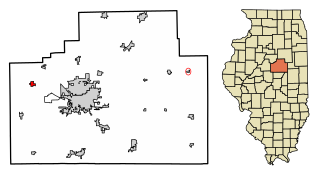
Danvers is a village in McLean County, Illinois, United States. The population was 1,154 as of the 2010 census. It is part of the Bloomington–Normal Metropolitan Statistical Area.

Ellsworth is a village in Dawson Township, McLean County, Illinois, United States. The population was 195 at the 2010 Census. It is part of the Bloomington–Normal Metropolitan Statistical Area.
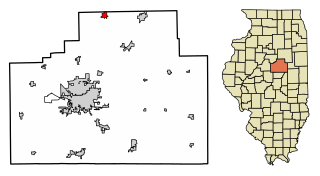
Gridley is a village in McLean County, Illinois, United States. The population consisted of 1,432 people at the end of the 2010 census. It is part of the Bloomington–Normal Metropolitan Statistical Area.

Le Roy is a city in McLean County, Illinois, United States. The population was 3,560 at the 2010 census.

Lexington is a city in McLean County, Illinois, United States. The population was 2,090 at the 2020 census. There are two theories regarding the etymology of the city name. One says it was named for the Battle of Lexington, where General Gridley's father fought. and the other that it was named for the home town of James Brown, the town's co-founder.
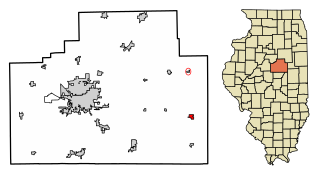
Saybrook is a village in southeast McLean County, Illinois, United States. The population was 693 at the 2010 census. It is part of the Bloomington–Normal Metropolitan Statistical Area.

Ambia is a town in Hickory Grove Township, Benton County, Indiana, United States. The population was 239 at the 2010 census. It is part of the Lafayette, Indiana Metropolitan Statistical Area.
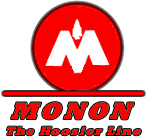
The Monon Railroad, also known as the Chicago, Indianapolis, and Louisville Railway from 1897 to 1971, was an American railroad that operated almost entirely within the state of Indiana. The Monon was merged into the Louisville and Nashville Railroad in 1971, and much of the former Monon right of way is owned today by CSX Transportation. In 1970, it operated 540 miles (870 km) of road on 792 miles (1,275 km) of track; that year it reported 1320 million ton-miles of revenue freight and zero passenger-miles.
The Indiana Railroad (IR) was the last of the typical Midwestern United States interurban lines. It was formed in 1930–31 by combining the operations of the five major interurban systems in central Indiana into one entity. The predecessor companies came under the control of Midland Utilities, owned by Samuel Insull. His plan was to modernize the profitable routes and abandon the unprofitable ones. With the onset of the Great Depression, the Insull empire collapsed and the Indiana Railroad was left with a decaying infrastructure and little hope of overcoming the growing competition of the automobile for passenger business and the truck for freight business. The IR faced bankruptcy in 1933, and Bowman Elder was designated as the receiver to run the company. Payments on bonded debt were suspended. Elder was able to keep the system virtually intact for four years, and IR operated about 600 miles (970 km) of interurban lines throughout Indiana during this period. During the late 1930s, the routes were abandoned one by one until a 1941 wreck with fatalities south of Indianapolis put an abrupt end to the Indiana Railroad's last passenger operations.
Cropsey is a small unincorporated community in McLean County, Illinois, United States. It was named for a Civil War colonel in the Union Army.

The Ruben M. Benjamin House is a house in Bloomington, Illinois. It is a two-story rectangular building, styled in the Classical Revival architectural motif. It was built in 1856 John L. Routt, who would become the first governor of Colorado. Ruben M. Benjamin, an attorney known for litigation relating to railroad regulation, lived in the home for more than 60 years. The United States National Register of Historic Places added the Ruben M. Benjamin House in August 1978.
The Chicago, Danville and Vincennes Railroad was a railroad company that served various communities along the eastern border of the U.S. state of Illinois in the 1870s. The original plan called for a line to connect Chicago with Lawrence County, Illinois via Danville and Paris; it ran from Chicago to Danville before it was consolidated into the Chicago and Eastern Illinois Railroad in 1877.

The Indiana Division or Coal Branch of the Chicago, Danville and Vincennes Railroad carried coal from mines south of Covington, Indiana in the 1870s.

Holder is an unincorporated community in Old Town Township, McLean County, Illinois.

The Vandalia Railroad Company was incorporated January 1, 1905, by a merger of several lines in Indiana and Illinois that formed a 471-mile railroad consisting of lines mostly west of Indianapolis.
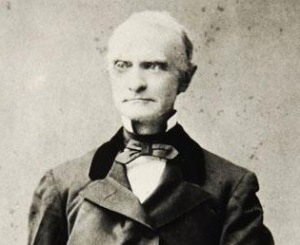
Asahel Gridley was an American politician, lawyer, merchant, and banker. Born in New York, Gridley moved to Bloomington, Illinois, when he was twenty-one. He served as a brigadier general in the Black Hawk War and was elected to three terms in the Illinois General Assembly. There, he lobbied to have the Illinois Central and Chicago and Alton Railroads pass near Bloomington. Abraham Lincoln once defended Gridley during a slander trial and was a frequent collaborator or opponent in the courts. Gridley is also the namesake of Gridley, Illinois, and platted two other McLean County towns.

















